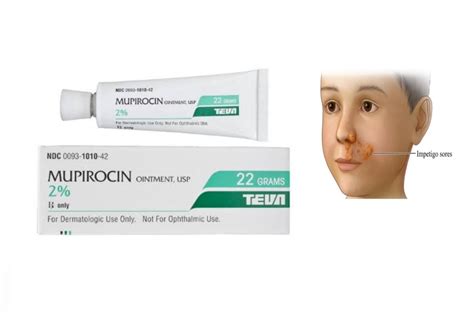Intro
Mupirocin ointment treats bacterial skin infections, impetigo, and MRSA. Apply topically for effective relief from symptoms like redness, swelling, and itching, promoting wound healing and preventing infection spread.
Mupirocin ointment is a topical antibiotic that has been widely used for several decades to treat various bacterial skin infections. The importance of this medication lies in its effectiveness against a range of gram-positive bacteria, including methicillin-resistant Staphylococcus aureus (MRSA), which is a significant concern in both healthcare settings and the community. Understanding the uses, benefits, and proper application of mupirocin ointment is crucial for individuals seeking to manage skin infections effectively.
The rise of antibiotic-resistant bacteria has made the treatment of skin infections increasingly challenging. Mupirocin ointment offers a valuable treatment option for such cases, given its unique mechanism of action that inhibits bacterial RNA synthesis, thereby preventing the bacteria from producing essential proteins and ultimately leading to their death. This mechanism is distinct from many other antibiotics, reducing the likelihood of cross-resistance.
Mupirocin ointment's applications extend beyond the treatment of acute infections; it is also used for the eradication of nasal colonization by MRSA, a common reservoir for infection. By eliminating the bacteria from the nasal cavity, healthcare providers can significantly reduce the risk of subsequent infections, especially in patients undergoing surgery or those with compromised immune systems. This aspect of mupirocin's use highlights its role in preventive care, making it a critical component of infection control strategies in healthcare settings.
Mupirocin Ointment Mechanism of Action

Benefits of Mupirocin Ointment
The benefits of using mupirocin ointment are multifaceted: - **Effective Against Resistant Strains**: Mupirocin is effective against bacteria that are resistant to other antibiotics, making it a valuable treatment option. - **Low Risk of Resistance Development**: The unique mechanism of action of mupirocin reduces the risk of bacteria developing resistance. - **Easy to Apply**: Mupirocin ointment is straightforward to apply, making it a convenient treatment option for patients. - **Minimally Absorbed**: Since mupirocin is minimally absorbed through the skin, it has a low risk of systemic side effects, making it safe for use in a variety of patients.Common Uses of Mupirocin Ointment

Application and Dosage
To ensure the effective use of mupirocin ointment, it is crucial to follow the application and dosage instructions carefully: - Apply a small amount of ointment to the affected area, usually three times a day. - The treatment duration can vary depending on the infection being treated but typically ranges from 5 to 14 days. - For nasal decolonization, apply the ointment to the inside of each nostril twice a day for 5 days.Potential Side Effects and Interactions

Precautions and Warnings
- **Pregnancy and Breastfeeding**: Mupirocin ointment should be used during pregnancy only if clearly needed, and caution is advised during breastfeeding. - **Hypersensitivity**: Individuals with a known hypersensitivity to mupirocin or any component of the ointment should avoid its use.Resistance and Future Perspectives

Conclusion and Recommendations
In conclusion, mupirocin ointment is a valuable treatment option for various bacterial skin infections, offering a unique mechanism of action that is effective against a range of gram-positive bacteria, including MRSA. Its use in both therapeutic and preventive strategies underscores its importance in managing skin infections and reducing the risk of infection in healthcare settings. Recommendations for its use should always be guided by healthcare professionals, considering the specific infection, patient health status, and potential for resistance.What is mupirocin ointment used for?
+Mupirocin ointment is used to treat various bacterial skin infections, including impetigo, folliculitis, and furuncles, as well as for the eradication of nasal colonization by MRSA.
How does mupirocin ointment work?
+Mupirocin ointment works by inhibiting the bacterial isoleucyl-tRNA synthetase enzyme, which is essential for protein synthesis, thereby preventing the bacteria from producing vital proteins necessary for their growth and survival.
What are the potential side effects of mupirocin ointment?
+Potential side effects include local irritation, such as redness, itching, and burning at the application site, and rare allergic reactions. High-level resistance to mupirocin, although rare, is a concern and typically associated with mutations in the ileS gene.
We invite readers to share their experiences or ask questions about the use of mupirocin ointment for bacterial skin infections. Your comments and inquiries can help others understand the benefits and proper use of this medication. Additionally, feel free to share this article with anyone who might benefit from knowing more about mupirocin ointment and its role in managing and preventing bacterial skin infections.
